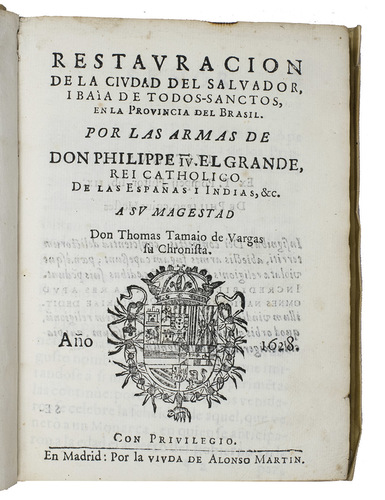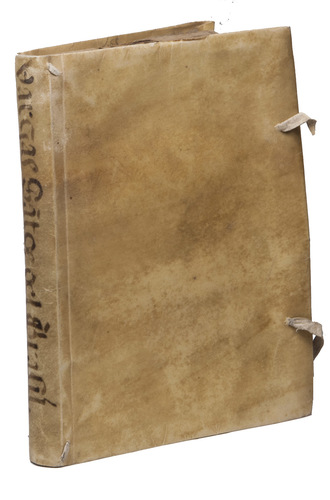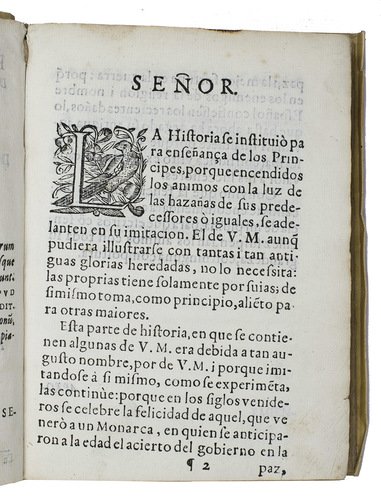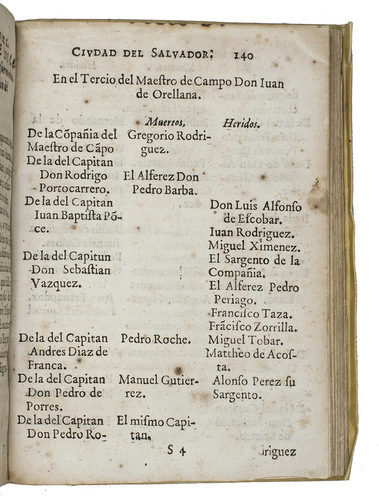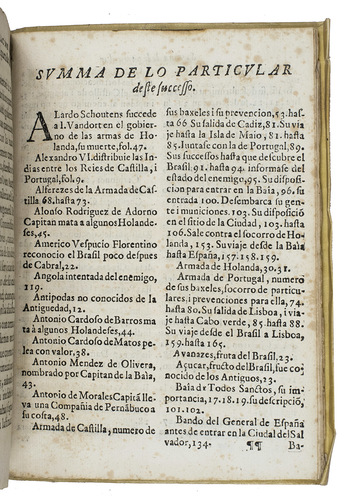TAMAYO DE VARGAS, Tomas.
Restauracion de la ciudad del Salvador i Baía de Todos-Sanctos, en la provincia del Brasil.
Madrid, widow of Alonso Martin, 1628. 4to. With the woodcut coat of arms of King Philip IV of Spain, crowned and with the Order of the Golden Fleece, on the title-page and 2 woodcut decorated initials. Contemporary limp vellum, manuscript title on spine, a mark ("Co D Sa") branded into the top edge, and (remnants of) white leather ties. [7], [1 blank], 178, [4] ll.
€ 25,000
First edition of the first significant account of the 1625 campaign by the combined Portuguese and Spanish forces to recapture the Brazilian city of Salvador de Bahia, which the Dutch had taken from the Spain in 1624. Several accounts of the retaking of Bahia were published, this one, by the royal chronicler, was the official one, so that the author had unrestricted access to military and eye-witness accounts.
"The fall and recapture of Salvador can be briefly summarized. The Dutch West India Company, formed in June 1621, sought a profitable and convenient way to wage war against Spain. Salvador, because of its location and sugar industry, offered a suitable target, and the Dutch hoped that the Portuguese dislike of Spanish rule might even cause the defenders to welcome to Dutch arrival. A powerful fleet was organized in 1623, but Spanish agents learned of its objective, and warnings were sent to the governor at Salvador. His efforts to prepare a defense were frustrated by local planters and the bishop, who were unconvinced of the danger. The Dutch fleet arrived in May, 1624. After a day of indecisive bombardment, the bravery of Vice-Admiral Piet Heyn ... in silencing the Portuguese shore batteries[,] and the lackluster performance of the local Brazilian troops[,] resulted in the city's fall ... the Dutch success was short-lived. In the countryside, the Portuguese soon regained their composure, and an active guerrilla campaign directed by the now-bellicose bishop kept the Dutch pinned down in the city during the following year. Meanwhile, the Spanish crown mobilized its response. The Spanish and Portuguese relief fleets met at Cape Verde and sailed for Bahia in February. The siege began on April 1, 1625, and, after some spirited initial fighting, the Dutch became demoralized, surrendering on May 1, 1625, to generous terms. The Spanish royal chronicler, Tomas Tamayo de Vargas, under royal direction and with access to various sources, produced the official history in 1628". (Schwartz, "The voyage of the vassals: royal power, noble obligations, and merchant capital before the Portuguese restoration of independence, 1624-1640", The American historical review, 96, no. 3 (1991) pp. 735-762).
Rare on the market and uncommon institutionally.
Leaves 177 and 178 are bound out of sequence after the 4 unnumbered leaves at the end. Light foxing throughout, hinges slightly worn, a tear in the last free endleaf. Otherwise in good condition. Borba de Moraes, p. 845 ("rare"); European Americana 628/126; Medina BHA 850 (calling for an apostillada leaf not found here or in Google Books examples); Palau 327113; Sabin 94280.
Related Subjects:





